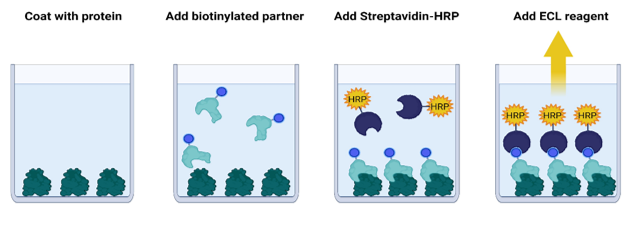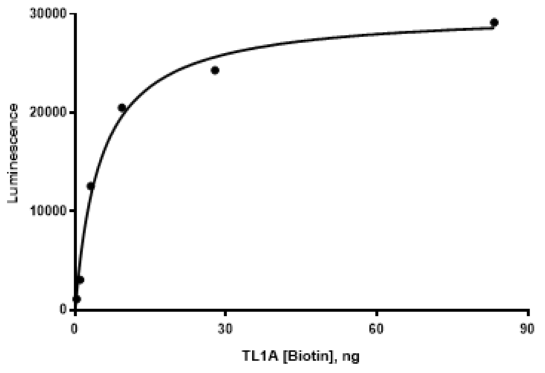DcR3:TL1A Inhibitor Screening Assay Kit
The DcR3:TL1A Inhibitor Screening Assay Kit is designed for screening and profiling inhibitors of the interaction between DcR3 (Decoy Receptor 3) and TL1A (TNF-like ligand 1A). This kit comes in a convenient 96-well format, with biotin-labeled TL1A, purified DcR3, streptavidin-labeled HRP, and assay buffer for 100 binding reactions.

Figure 1: DcR3:TL1A Inhibitor Screening Assay Kit workflow diagram.
First, DcR3 is coated on a 96-well plate. Next, biotinylated TL1A is incubated with DcR3. Finally, the plate is treated with streptavidin-HRP followed by addition of an HRP substrate to produce chemiluminescence. The chemiluminescence signal is proportional to the binding of DcR3:TL1A.
- 1x PBS (Phosphate Buffer Saline)
- Luminometer or plate reader capable of reading chemiluminescence
- Adjustable micropipettor and sterile tips
- Orbital shaker
| Catalog # | Name | Amount | Storage |
| 101882 | TL1A, His-Tag, Avi-Tag, Biotin-Labeled* | 5 µg | -80 °C |
| DcR3* | 25 µg | -80 °C | |
| 79311 | 3x Immuno Buffer 1 | 50 ml | -20 °C |
| 79728 | Blocking Buffer 2 | 50 ml | +4 °C |
| 79742 | Streptavidin-HRP | 10 µl | +4 °C |
| 79670 | ELISA ECL Substrate A (translucent bottle) | 6 ml | Room Temp |
| ELISA ECL Substrate B (brown bottle) | 6 ml | Room Temp | |
| 79699 | 96-well white microplate | 1 | Room Temp |
* The concentration of protein is lot-specific and will be indicated on the tube containing the protein.
Decoy receptor 3 (DcR3) is a soluble receptor of the tumor necrosis factor receptor superfamily of proteins (TNFRSF), which associates with its respective ligands, such as TL1A, FasL and LIGHT. DcR3 has been recognized as a significant anti-apoptotic factor with prominent involvement in various inflammatory and neoplastic conditions. Increased intratumor expression of DcR3 and elevated soluble DcR3 protein content in the sera of patients has been reported for various malignancies. TL1A, also called TNFSF15, is a member of the tumor necrosis factor family. It is expressed in different immune cells, such as monocyte, macrophage, dendritic cell, T cell and non-immune cells. TL1A competitively binds to DcR3, providing stimulatory signal for downstream signaling pathways, and then regulates proliferation, activation, apoptosis, and chemokine production in effector cells. Inhibition of DcR3-TL1A interaction has substantial therapeutic potential.
Lagou,S., et al., 2022 Cancer Diagn. Progn. 2(4): 411-421.
Xu, W.-D., et al., 2022 Front. Immunol. 13: 1-10.



